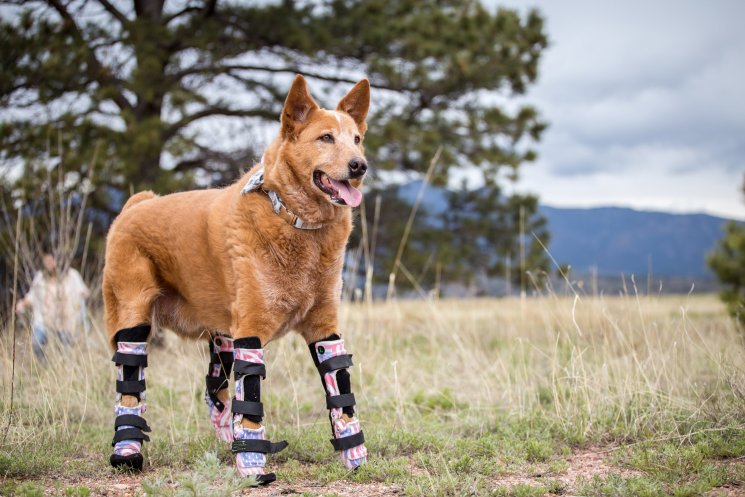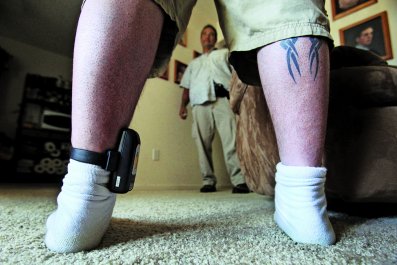When animal rescue took Noah from his former owner's house and brought the German shepherd to Houston's VERGI emergency hospital in late September, Dr. Sarah Dewhirst was "horrified by the neglect and abuse" she saw. The fur and pads were gone from Noah's right front paw; all that was left was exposed bones and infected tissue. "My initial reaction was just to amputate at the shoulder," says the veterinarian, citing standard practice for severely injured dogs.
Then a colleague told Dewhirst about Bill Bickley, founder of the Houston-based Pet Artificial Limbs and Supports (PALS). Bickley, 46, is a new breed of specialist, creating animal orthotics and prosthetics. For over a decade, he worked on human limbs. Then, three years ago, Bickley read about the small but growing field of animal orthotics and prosthetics, pioneered in the first years of this century largely by Martin and Amy Kaufmann, founders of Colorado-based OrthoPets; Jeff Collins of K-9 Orthotics and Prosthetics in Nova Scotia; and Derrick Campana of Animal Ortho Care in Virginia.
The industry giant is OrthoPets, which started accidentally in 2002 when a cousin's schnauzer had a stroke and needed an orthotic. Soon the Kaufmanns turned a 400-square-foot garage into an orthotics and prosthetics facility, and in 2007 they made OrthoPets their full-time focus. Now they have 21 employees and 200 patients a month via distribution centers all over the world. Using videos, pictures and details from veterinarians, they work with clients in South America, Europe and Asia.
Still, Bickley saw room for innovation. Most limbs he saw "were heavy-duty without a lot of finesse—they had no bounce or natural motion." So Bickley started pondering and tinkering, finally hitting on the idea of using carbon fiber, which is both strong and flexible; it's the material of the blades for runners who are amputees. But Bickley needed some carbon fiber to actually test the idea. The first five places he called "either laughed at me or said they'd only do it for a big production run and a lot of money." He left a voice mail for Hans DeBot, whose company, deBotech, has used carbon fiber to help build everything from Olympic bobsleds to military aircraft and Lamborghinis. Bickley was simply hoping DeBot might recommend a smaller operator willing to help.
"But I have three dogs and love animals, so I said, 'I'll help you, and we'll worry about the cost later,'" DeBot says. The two collaborated on the project, testing prototypes until they hit an idea: different "spring rates" based on the size of the dog for the carbon fiber blades that act as the dog's legs. Eventually, they also fine-tuned a back leg with progressive stiffness, DeBot says, going from less flexible up top to more pliant near the bottom. Bickley then created a "foot" by injecting silicone gel into a cup pad at the bottom of the leg to provide the dog with a softer landing.
The other leaders in the field have their own approaches and innovations. At OrthoPets, for example, the company takes a fiberglass impression of a limb, scans it and makes a 3-D model. A machine carves the final shape from a block of foam. Then the prosthesis gets vacuum-sealed with plastic.
While Bickley still earns much of his living working with humans, in two years he has built up recognition locally. He helps mostly dogs, but he has also provided a knee brace for a flamingo at the local zoo and a prosthetic leg for a ram. One prosthetic dog leg typically costs around $1,500, plus $100 in annual maintenance because the dogs chew the straps that connect the artificial limb to their leg.
"He has made a huge difference in the services we provide," says Dr. Brian Beale, a surgeon at Gulf Coast Veterinary Specialists in Houston. "The carbon fiber provides more flexibility and probably feels more natural to the dog, so they can really run on these things." Beale also praises Bickley's orthotics—custom braces, for example—and explains that while the prosthetic is the more dramatic fix, the orthotics can often help a pet avoid surgery. (All the companies say orthotics is 80 to 90 percent of their business.)
The field is so new that there's no formal education or licensing program, nor have any real studies been conducted about the impact of orthotics and prosthetics. Beale says, for many vets, "the mindset is still just to cut the leg off and assume the other three are good enough," though he thinks that will change if vets and owners see the difference a prosthetic makes. Dewhirst says living on three legs can "lead to arthritis and potentially decrease a dog's life span." But when she was in school in 2009, she heard of only occasional cases of prosthetic work, which is why her instinct had been to amputate Noah's leg at the shoulder.
Fortunately for Noah, Dewhirst heard about the new prosthetics. After she reached out to Bickley, a local animal rescue group started a social media campaign to raise awareness and money for his new leg. Then Dewhirst's colleague at VERGI, Dr. Steve Pittenger, performed the operation that would allow Bickley to attach the prosthetic leg. The operation was a success, and now Noah's walking around on all fours again.
Bickley, Campana and Martin Kaufmann try to spread the word to vets at surgical conferences and to owners at dog clubs and pet expos. "There's a lot more awareness than there was five years ago," says Amy Kaufmann. In some veterinary schools, animal prosthetics have already become part of the curriculum. Dr. Jamie Peyton, service chief at the UC Davis Veterinary Medical Teaching Hospital's Integrative Medicine Service, says her students attend lectures on the subject and a weekly clinic in which she works with orthotists and prosthetists on not only dogs and cats but also livestock.
In addition, Peyton serves on a committee at the American Association of Rehabilitation Veterinarians, whose goal is to spread the word on animal orthotics and prosthetics to other universities. And the Kaufmanns have written a textbook on the subject due in 2016 that they think will further fuel awareness. "It will change standard protocol taught in veterinary schools," Amy Kaufman says.
"The textbook will be valuable," says Peyton, "but what is really going to change people's minds is when they see the difference. And the best exposure is clinical exposure—when they see a dog with three legs, and then they see a dog running more naturally with a prosthetic."























